Comparison of Two Detector Magnetic Systems for the Future Circular Hadron-Hadron Collider
Abstract
:Featured Application
Abstract
1. Introduction
2. Modeling the Magnetic Systems
2.1. Reference Geometry of the FCC-hh Detector
2.2. Baseline Magnetic System Model
2.3. Minimal Steel Yoke Magnetic System
3. Comparison of the Magnetic Systems
3.1. General Comparisons
3.2. Magnetic Field Double Integral Comparisons
- I2bh—double integral in homogeneous constant magnetic field of 4.000174 T, that corresponds to the central magnetic flux density in the baseline configuration of the magnetic system.
- I2bi—double integral in the real inhomogeneous magnetic field of the baseline configuration of the magnetic system.
- I2mh—double integral in homogeneous constant magnetic field of 4.243783 T, that corresponds to the central magnetic flux density in the minimal steel yoke configuration of the magnetic system.
- I2mi—double integral in the real inhomogeneous magnetic field of the minimal steel yoke configuration of the magnetic system.
4. Discussion
- 6% larger central magnetic flux density.
- 13.2% smaller compression axial force and pressure in the main coil middle plane.
- 16.2% smaller radial pressure in each forward coil.
- 12.1% shorter radial distance to the acceptable safety level of the magnetic stray field.
- 7.2% shorter axial distance to the acceptable safety level of the magnetic stray field.
- 3.2 to 8.1% larger magnetic field double integrals and, thus, better transverse momentum resolution of the charged particle registered in the inner tracker.
- 0.97% larger axial attractive force onto each forward coil.
- 9.3% lower magnetic flux density in the transition region between central and each forward coil.
- 5.8% larger stored energy in the magnetic system.
- 61.3% larger radial pressure in the main coil.
- The compression axial force to the central barrel wheel of 236.9 MN each side is 2.92 times larger than the similar axial force in the CMS magnet yoke at the 3.81 T central field.
- The attractive axial force to the yoke endcap assembly of 164 MN from each side is 2.42 times larger than the similar axial forces in the CMS magnet yoke at the 3.81 T central field.
5. Conclusions
Author Contributions
Funding
Institutional Review Board Statement
Informed Consent Statement
Data Availability Statement
Acknowledgments
Conflicts of Interest
References
- Future Circular Collider Study Kickoff Meeting, 12–15 February 2014, University of Geneva—UNI MAIL. Available online: https://indico.cern.ch/event/282344/ (accessed on 6 September 2023).
- Abada, A.; Abbrescia, M.; AbdusSalam, S.S.; Abdyukhanov, I.; Fernandez, J.A.; Abramov, A.; Aburaia, M.; Acar, A.O.; Adzic, P.R.; Agrawal, P.; et al. FCC Physics Opportunities. Future Circular Collider Conceptual Design Report Volume 1. Eur. Phys. J. C 2019, 79, 474. [Google Scholar] [CrossRef]
- Abada, A.; Abbrescia, M.; AbdusSalam, S.S.; Abdyukhanov, I.; Fernandez, J.A.; Abramov, A.; Aburaia, M.; Acar, A.O.; Adzic, P.R.; Agrawal, P.; et al. FCC-hh: The Hadron Collider. Future Circular Collider Conceptual Design Report Volume 3. Eur. Phys. J. Spec. Top. 2019, 228, 755–1107. [Google Scholar] [CrossRef]
- Mentink, M.; Silva, H.; Dudarev, A.; Bielert, E.; Klyukhin, V.; Cure, B.; Gerwig, H.; Gaddi, A.; Berriaud, C.; Wagner, U.; et al. Evolution of the Conceptual FCC-hh Baseline Detector Magnet Design. IEEE Trans. Appl. Supercond. 2018, 28, 4002710. [Google Scholar] [CrossRef]
- Klyukhin, V.I.; Hervé, A.; Ball, A.; Curé, B.; Dudarev, A.; Gaddi, A.; Gerwig, H.; Mentink, M.; Da Silva, H.P.; Rolando, G.; et al. Superconducting Magnet with a Minimal Steel Yoke for the Future Circular Collider Detector. J. Supercond. Nov. Magn. 2017, 30, 2309–2313. [Google Scholar] [CrossRef]
- TOSCA/OPERA-3d 18R2 Reference Manual; Cobham CTS Ltd.: Kidlington, UK, 2018; pp. 1–916.
- Klyukhin, V.; CMS Collaboration. Influence of the high granularity calorimeter stainless steel absorbers onto the Compact Muon Solenoid inner magnetic field. SN Appl. Sci. 2022, 4, 235. [Google Scholar] [CrossRef]
- ATLAS Collaboration. The ATLAS Experiment at the CERN Large Hadron Collider. J. Instrum. 2008, 3, S08003. [Google Scholar] [CrossRef]
- CMS Collaboration. The CMS Experiment at the CERN LHC. J. Instrum. 2008, 3, S08004. [Google Scholar] [CrossRef]
- Evans, L.; Bryant, P. LHC Machine. J. Instrum. 2008, 3, S08001. [Google Scholar] [CrossRef]
- CMS. The Magnet Project; Technical Design Report, CERN/LHCC 97-10, CMS TDR 1; CERN: Geneva, Switzerland, 1997; ISBN 92-9083-101-4. Available online: http://cds.cern.ch/record/331056 (accessed on 6 September 2023).
- Mentink, M.; Dudarev, A.; Da Silva, H.F.P.; Berriaud, C.P.; Rolando, G.; Pots, R.; Cure, B.; Gaddi, A.; Klyukhin, V.; Gerwig, H.; et al. Design of a 56-GJ Twin Solenoid and Dipoles Detector Magnet System for the Future Circular Collider. IEEE Trans. Appl. Supercond. 2016, 26, 4003506. [Google Scholar] [CrossRef]
- Mentink, M.; Dudarev, A.; Pais Da Silva, H.F.; Rolando, G.; Cure, B.; Gaddi, A.; Klyukhin, V.; Gerwig, H.; Wagner, U.; ten Kate, H. Iron-free detector magnet options for the future circular collider. Phys. Rev. Accel. Beams 2016, 19, 111001. [Google Scholar] [CrossRef]
- Gluckstern, R.L. Uncertainties in track momentum and direction, due to multiple scattering and measurement errors. Nucl. Instrum. Methods 1963, 24, 381–389. [Google Scholar] [CrossRef]
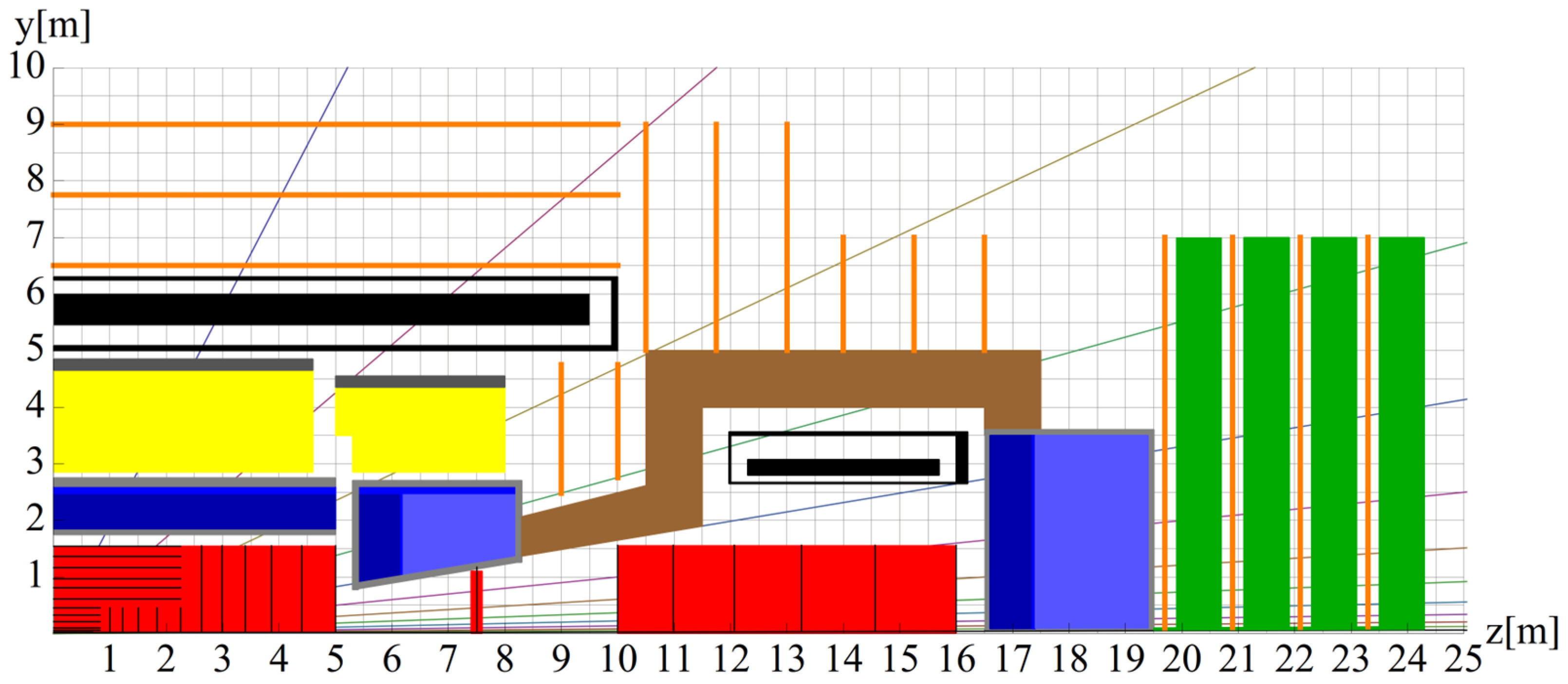
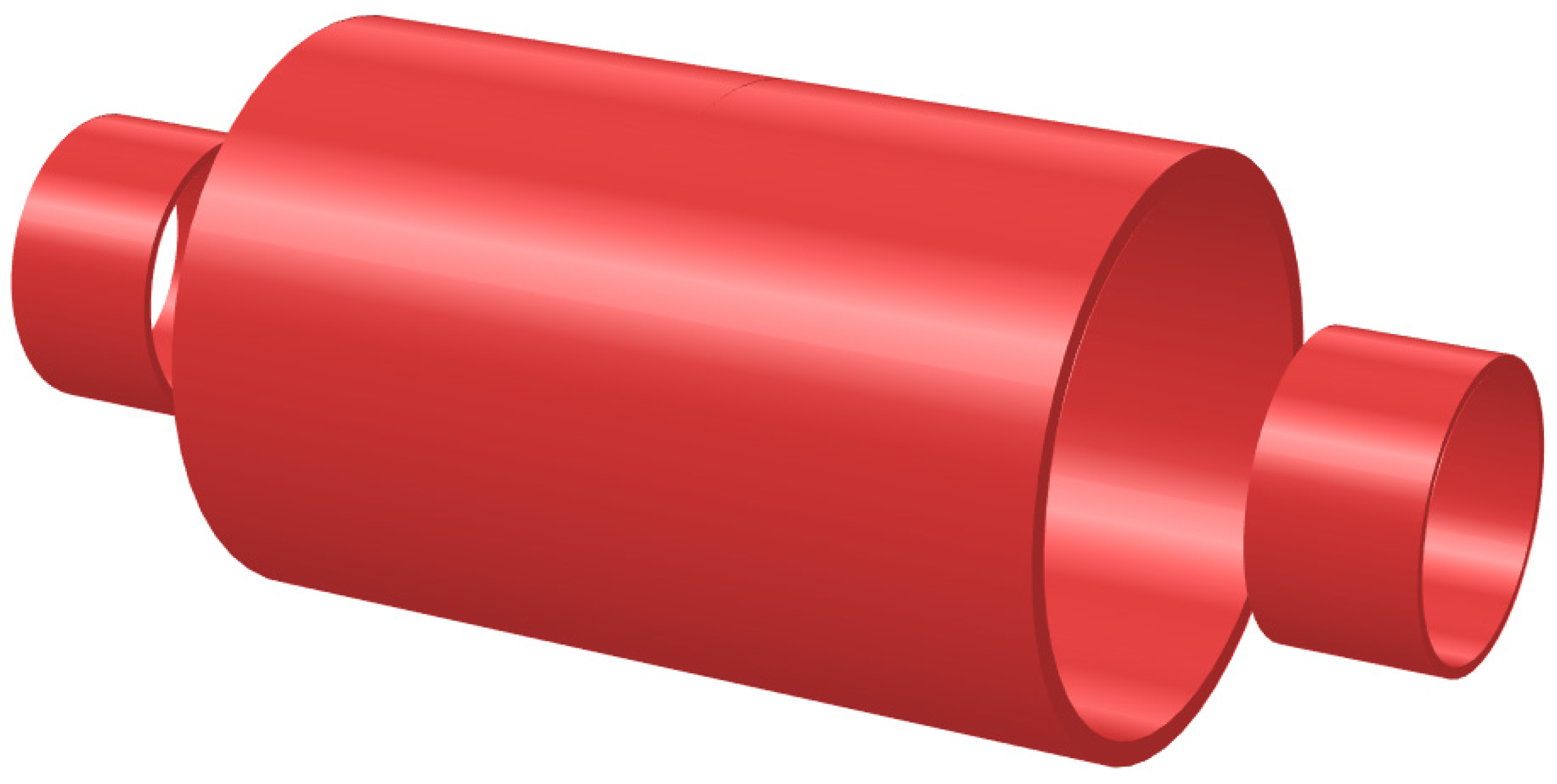
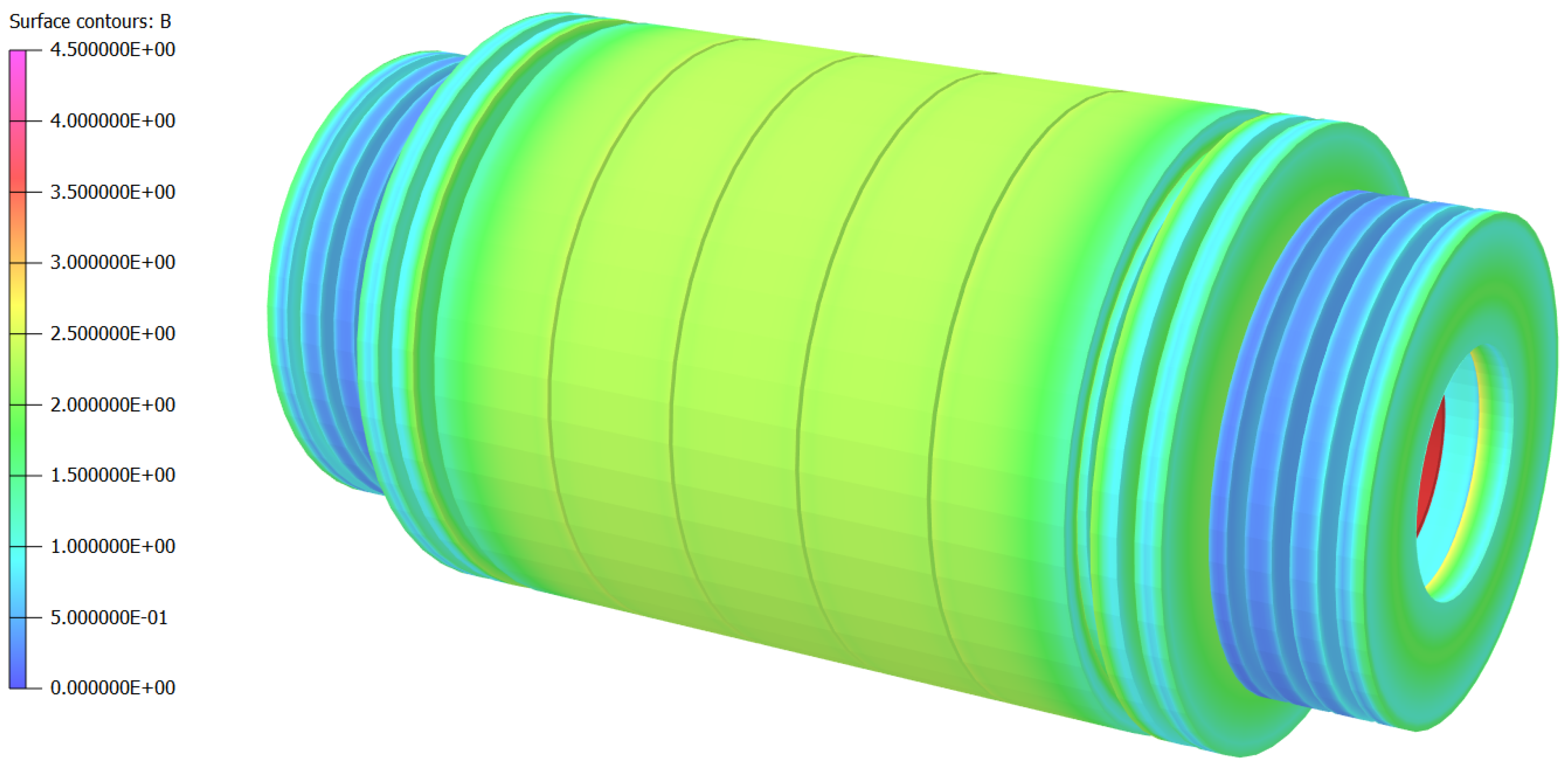
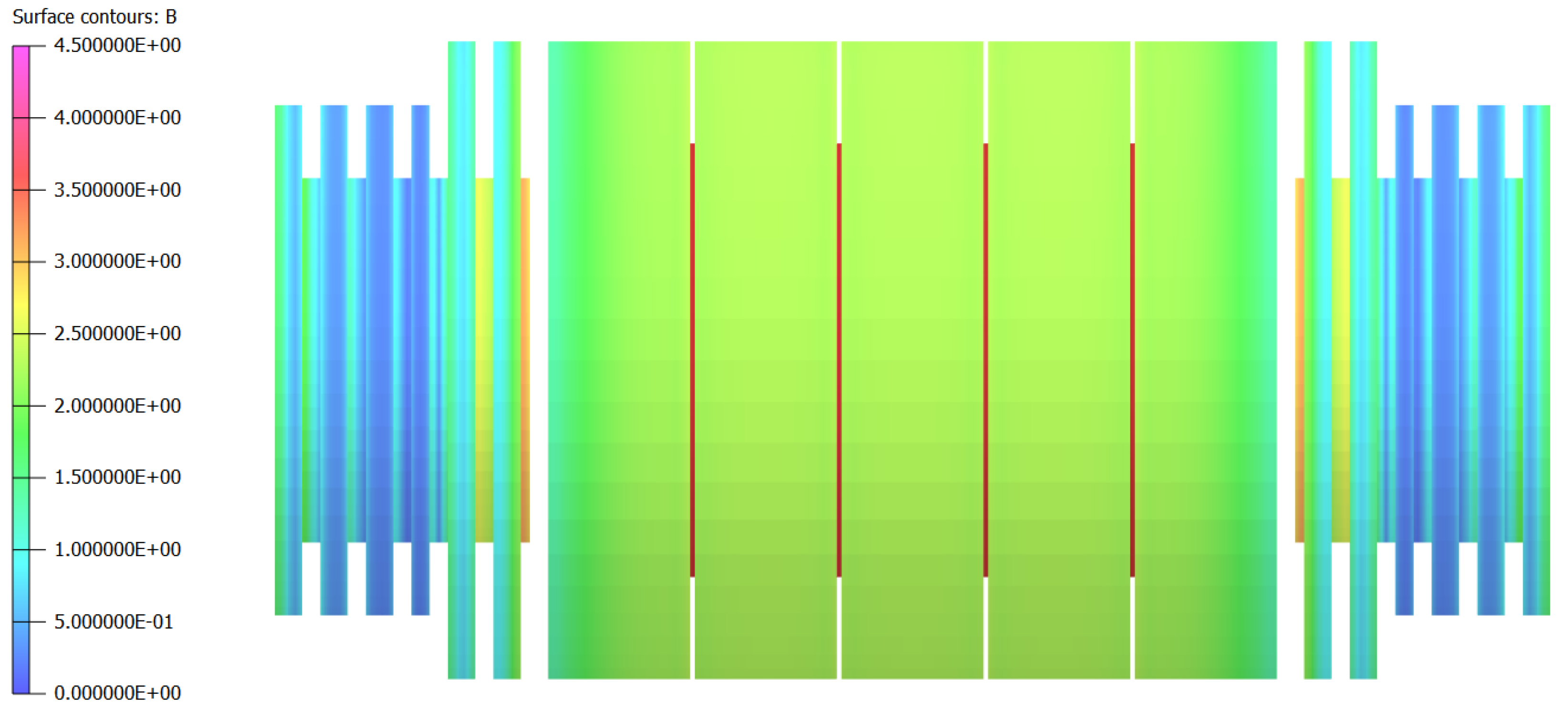


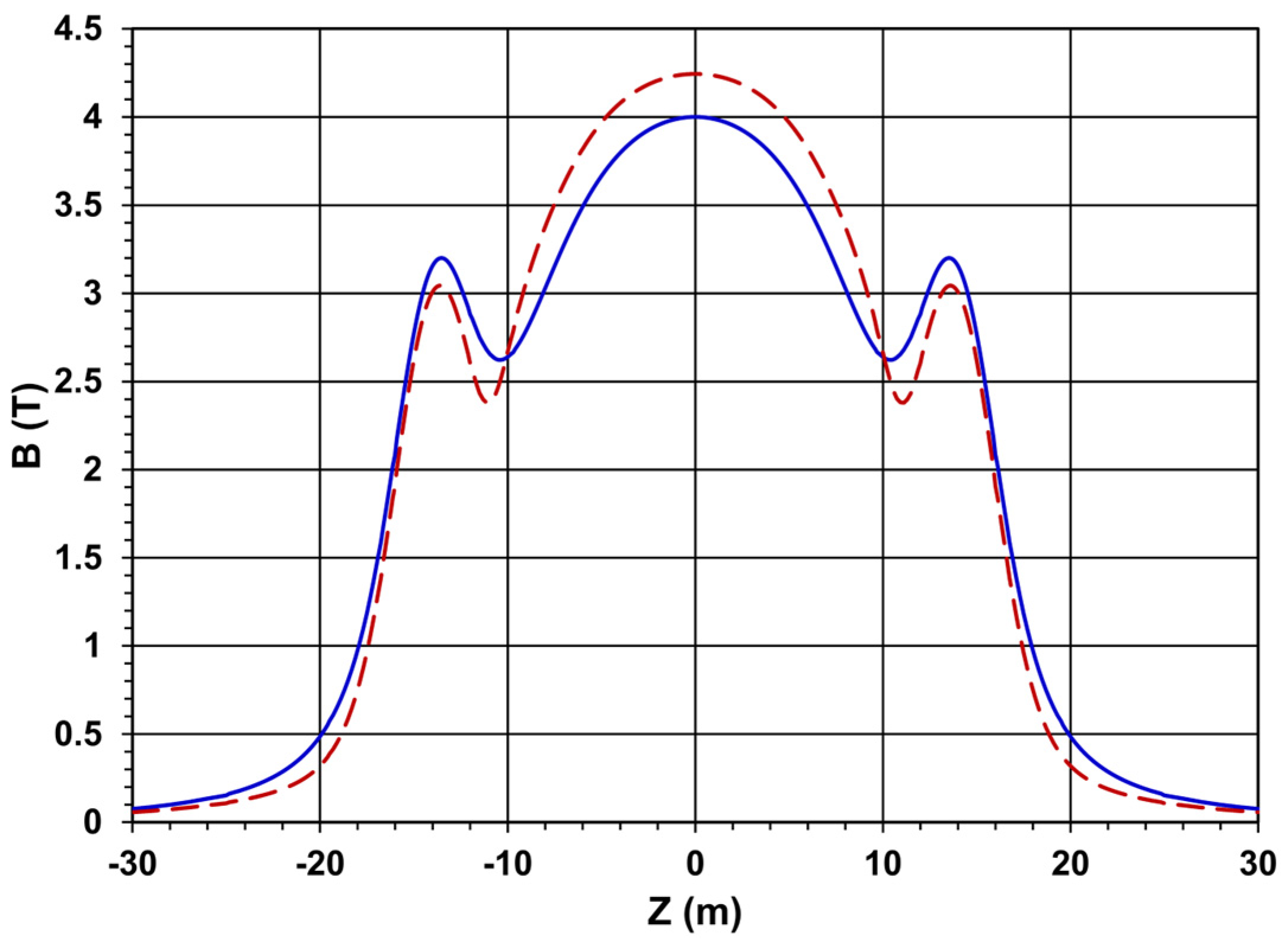

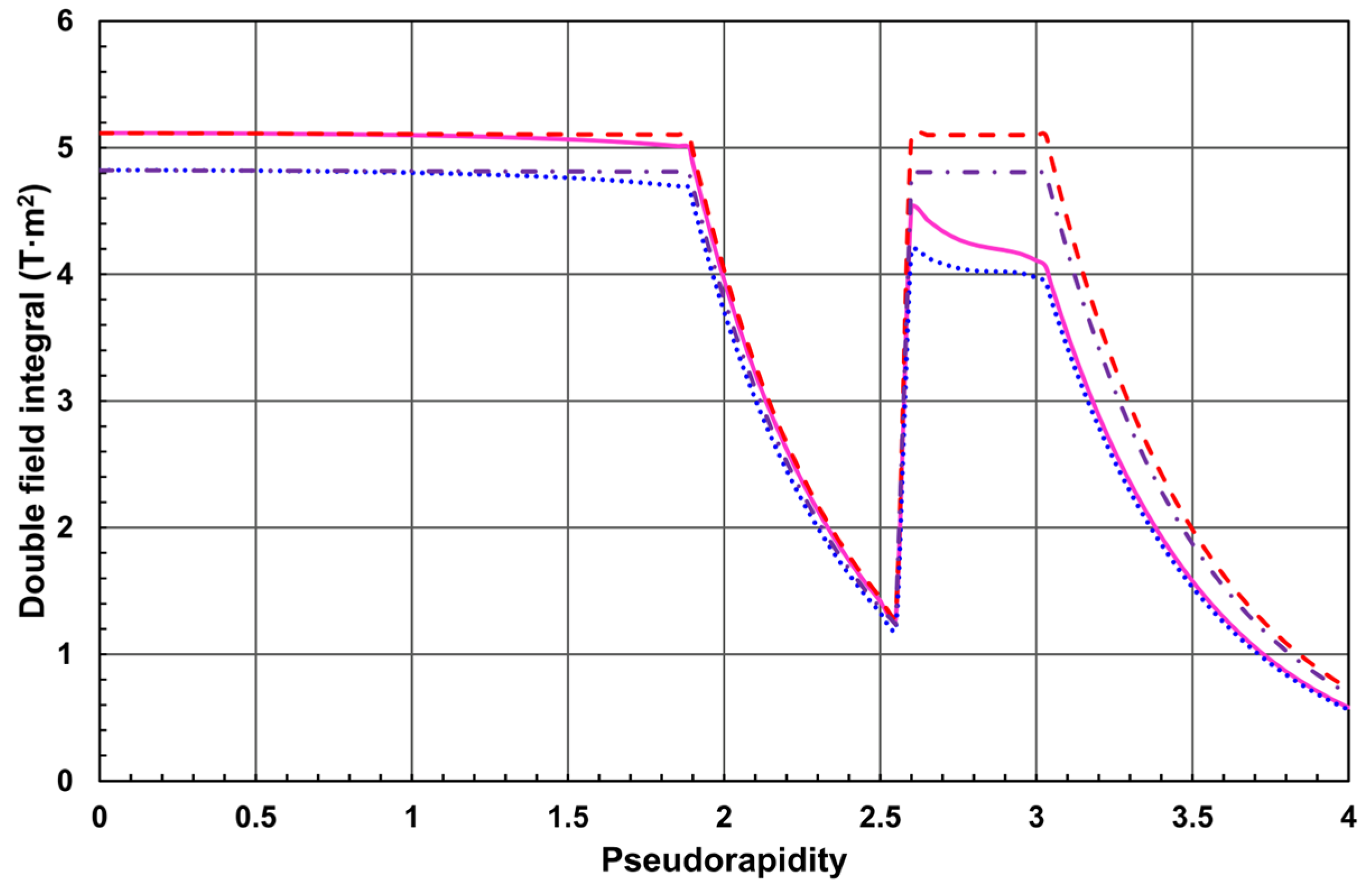

Disclaimer/Publisher’s Note: The statements, opinions and data contained in all publications are solely those of the individual author(s) and contributor(s) and not of MDPI and/or the editor(s). MDPI and/or the editor(s) disclaim responsibility for any injury to people or property resulting from any ideas, methods, instructions or products referred to in the content. |
© 2023 by the authors. Licensee MDPI, Basel, Switzerland. This article is an open access article distributed under the terms and conditions of the Creative Commons Attribution (CC BY) license (https://creativecommons.org/licenses/by/4.0/).
Share and Cite
Klyukhin, V.; Ball, A.; Berriaud, C.P.; Curé, B.; Dudarev, A.; Gaddi, A.; Gerwig, H.; Hervé, A.; Mentink, M.; Riegler, W.; et al. Comparison of Two Detector Magnetic Systems for the Future Circular Hadron-Hadron Collider. Appl. Sci. 2023, 13, 10387. https://doi.org/10.3390/app131810387
Klyukhin V, Ball A, Berriaud CP, Curé B, Dudarev A, Gaddi A, Gerwig H, Hervé A, Mentink M, Riegler W, et al. Comparison of Two Detector Magnetic Systems for the Future Circular Hadron-Hadron Collider. Applied Sciences. 2023; 13(18):10387. https://doi.org/10.3390/app131810387
Chicago/Turabian StyleKlyukhin, Vyacheslav, Austin Ball, Christophe Paul Berriaud, Benoit Curé, Alexey Dudarev, Andrea Gaddi, Hubert Gerwig, Alain Hervé, Matthias Mentink, Werner Riegler, and et al. 2023. "Comparison of Two Detector Magnetic Systems for the Future Circular Hadron-Hadron Collider" Applied Sciences 13, no. 18: 10387. https://doi.org/10.3390/app131810387
APA StyleKlyukhin, V., Ball, A., Berriaud, C. P., Curé, B., Dudarev, A., Gaddi, A., Gerwig, H., Hervé, A., Mentink, M., Riegler, W., Wagner, U., & Ten Kate, H. (2023). Comparison of Two Detector Magnetic Systems for the Future Circular Hadron-Hadron Collider. Applied Sciences, 13(18), 10387. https://doi.org/10.3390/app131810387






